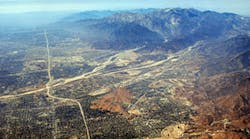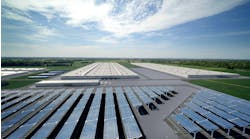Note to Manufacturers: California Might Not Be so Bad
If you’re looking to set up shop or expand operations in a west coast market, don’t automatically strike California off your list of potential sites. Believe it or not, there are places all over the state that are friendly to manufacturing.
Yes, the Golden State has a terrible reputation as a place to do business, a reputation it has earned over the years and richly deserves. Its taxes are high, it has far too much red tape and its environmental laws are so draconian that, by themselves, they keep a lot of manufacturers from thinking about locating or expanding in the state.
But if you’re a manufacturer and the west coast is the market you need to conquer, California may be the right place to do business. All you have to do is find a suitable location in one of the state’s 40 enterprise zones.
Enterprise zones were established in California in 1984 by the state Department of Housing and Community Development to bring businesses and jobs to economically depressed areas. Today they have become a collective oasis in a state that otherwise seems to close its doors to most manufacturers, despite the fact that manufacturers provide high-paying jobs and are generally considered the backbone of an economy.
Just last year, Amazon.com and Korea-based Samsung Semiconductor Inc. further expanded in California by locating to enterprise zone sites around the state. Tripling their space and workforce in Northern California, Samsung Semiconductor expanded their research and development site into a 680,000-square-foot building in the San Jose Enterprise Zone, which was highly celebrated by Gov. Jerry Brown.
Amazon.com, the mega online retailer of books and any other consumer products you can think of, recently opened a new 950,000-square-foot fulfillment center in the San Bernardino Valley Enterprise Zone (SBVEZ), producing approximately 1,000 new jobs in the area.
Like many zones, the SBVEZ--which includes Colton, San Bernardino and parts of unincorporated San Bernardino County--has attracted dozens of new businesses that recognized the program’s value in offsetting high labor costs, while making it possible to expand their workforce with local hires. Among those being Global Environmental Products, a manufacturer of high-performance industrial road sweepers and specialized cleaning equipment that established operations in San Bernardino in 2011.
“Labor costs are always the largest expenditure for a manufacturer and we knew immediately that the assistance of the enterprise zone program would allow us to make the smart hiring investments we needed to grow,” said Naomi Thompson, operations manager at Global Environmental Products. Like many start ups, their site location depended greatly on finding a place that would drive their success during the first few years of operation. “By using the program as a hiring tool we have been able to double our workforce with local hires in just two years, and expand into a much larger facility in San Bernardino,” said Thompson.
In its first two years, Global Environmental Products relocated to a 100,000 square-foot site and expanded its workforce to 52 mechanic technicians, welders and assembly workers. More than 40 of their workers have been hired and trained because of the enterprise zone program.
These sites are attractive to businesses because any company, manufacturing or otherwise, that sets up shop in an enterprise zone can qualify for a number of incentives, all of which can go a long way towards offsetting operating costs. The credits are granted for pro-growth business investments that have a positive impact on the community and local economy, such as hiring workers from communities characterized by chronic high unemployment and low income, and for making capital improvements and equipment purchases.
During the last few years, other nearby states such as Texas, Nevada and Arizona have emphasized California’s high cost of business to differentiate and attract companies to their commercial sites. But despite many of their offers, California’s enterprise zone can still be more beneficial long term than locating to a state perceived to be “business friendly.” Many incentive programs seem equal, but poor tax structure can end up lowering net value over time, making that state less friendly than you think when examined closely.
“We were heavily courted by other states looking to recruit businesses by offering lower costs,” said Rick Snyder, president and owner of Colton-based U.S. Rubber Recycling that decided to stay in the state because of the program. “But we chose to stay in California, rather than relocate to Arizona once we discovered the enterprise zone. After comparing the benefits offered by Arizona to those of the enterprise zone, it made more sense to stay local.”
The same is true of Simpson Strong-Tie, a leading manufacturer of structural building products for more than 50 years that consolidated its southwest operations in the SBVEZ.
“Several years ago when we were looking to consolidate six southwest facilities into one we considered moving out of state,” said "Andrea De Corte, branch controller with Simpson Strong-Tie that now operates its southwest division out of an unincorporated area in San Bernardino County. “However, the benefits of the enterprise zone program and the availability of affordable industrial properties in the Inland Empire help tip the scale to remain here. The benefits of the program are allowing us to hire and train workers from the local labor pool and proceed with other pro-growth investments that will ensure we remain an industry leader for another 50 years.”
In 2011, Simpson Strong-Tie relocated to a 400,000-square foot facility large enough to accommodate future business growth. Since then, the company has used the sales and use tax credits to upgrade crucial equipment for their production processes and also expanded their workforce by 10% with local hires, many of which were selected based on their eligibility for the enterprise zone program.
Enterprise zones across California continue to be the most competitive locations for business in the state. The program is one of the few incentives keeping the state globally competitive for manufacturers. Human capital is the most important and expensive investment manufacturers make, and the program helps companies pencil out a workforce in California.
How to Get Started
If you’re considering locating in an enterprise zone, there are two steps you should take to make the process easier.
First, find a tax consultant that is familiar with enterprise zones, or one who specializes in them. That person can educate you about the full benefits of the program and help you determine its value to that of other locations.
Second, find a real estate agent who knows enterprise zones and other local incentive programs, someone who can show you how to get the maximum in reduced rent costs. Locating in an enterprise zone can save you anywhere from two to three cents per square foot a month on your lease.
Wendy Clements is zone manager for San Bernardino Valley Enterprise Zone.




